Are You a Fan of Abraham Lincoln? Here’s Why the 1969 Penny Might Interest You
If you’re passionate about Abraham Lincoln and enjoy collecting historical memorabilia, the 1969 Lincoln cent is definitely worth a closer look. This striking coin, featuring the beloved 16th President, was produced in massive numbers and remains a staple in many collections today.
Although it’s not considered rare due to its high mintage, certain versions of the 1969 penny—particularly those with specific mint errors or in exceptional condition—can be quite valuable. In fact, some examples can command hundreds of dollars on the market.
In this guide, you’ll get a clear overview of the 1969 penny’s current value based on color, mint mark, and condition, so you can make an informed decision whether buying or selling.
1969 Lincoln Penny Value Breakdown
| Mint & Color | Good | Fine | Extremely Fine | Uncirculated |
|---|---|---|---|---|
| 1969 (No Mint Mark) – Brown | $0.05 | $0.05 | $0.05 | $7.50 |
| 1969 (No Mint Mark) – Red Brown | $0.05 | $0.05 | $0.05 | $15 |
| 1969 (No Mint Mark) – Red | $0.05 | $0.05 | $0.05 | $300 |
| 1969 D – Brown | $0.05 | $0.05 | $0.05 | $7.50 |
| 1969 D – Red Brown | $0.05 | $0.05 | $0.05 | $15 |
| 1969 D – Red | $0.05 | $0.05 | $0.05 | $380 |
| 1969 S – Brown | $0.05 | $0.05 | $0.05 | $7.50 |
| 1969 S – Red Brown | $0.05 | $0.05 | $0.05 | $20 |
| 1969 S – Red | $0.05 | $0.05 | $0.05 | $400 |
| 1969 S – Proof | – | – | – | $30 |
As you can see, red uncirculated specimens are the most desirable and command significantly higher prices—especially those from the San Francisco Mint (1969 S).
History of the 1969 Penny

Abraham Lincoln, el 16.º Presidente de los Estados Unidos, es recordado como un firme opositor a la esclavitud. Su legado incluye el famoso Discurso de Gettysburg y la Proclamación de Emancipación, una declaración histórica que marcó el inicio del fin de la esclavitud en América.
Lamentablemente, Lincoln fue asesinado por un simpatizante confederado el 21 de abril de 1865. Décadas después, en 1909, la Casa de la Moneda de EE. UU. lo homenajeó emitiendo una moneda conmemorativa por el centenario de su nacimiento.
El centavo de Lincoln, introducido por primera vez ese año, fue diseñado por el artista Victor David Brenner, quien creó tanto el anverso como el reverso de la moneda. El anverso, que presenta el retrato de Lincoln, no ha cambiado desde su creación. En cambio, el reverso ha sido rediseñado varias veces. Inicialmente mostraba dos espigas de trigo, pero en 1959 fue reemplazado por la imagen del Lincoln Memorial.
El centavo de 1969 mantiene esta tradición, mostrando el busto de Lincoln en el anverso y el Memorial en el reverso.
Curiosamente, el centavo de Lincoln fue la primera moneda estadounidense de circulación regular en mostrar la imagen de un presidente, algo que George Washington había rechazado firmemente. A pesar de esta resistencia inicial, el público recibió la moneda con entusiasmo, y la Casa de la Moneda la lanzó oficialmente en circulación en agosto de 1909.
Features of the 1969 Penny
The obverse of the 1969 Penny
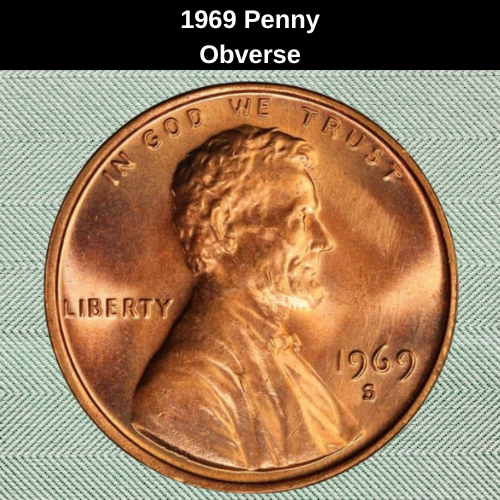
On the front side of the coin, you’ll find a right-facing image of President Abraham Lincoln, a design created by Victor David Brenner.
At the top edge of the coin, the motto “IN GOD WE TRUST” is inscribed.
To the left of Lincoln’s profile, the word “LIBERTY” appears, while the year 1969 is shown to the right, near his chest.
If the coin is in good condition, you might also spot the initials “VDB” near Lincoln’s shoulder, which stand for Victor David Brenner, the artist behind the design.
The reverse of the 1969 Penny
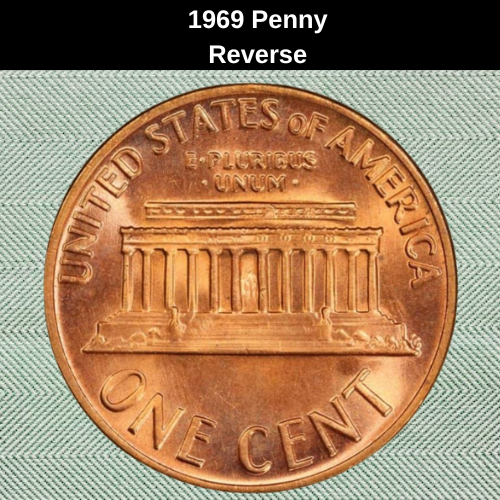
The back of the coin showcases the Lincoln Memorial, a structure erected in 1922 to honor President Abraham Lincoln. This reverse design was created by Frank Gasparro.
If you look closely, you’ll notice a tiny seated figure of Lincoln inside the memorial — a miniature version of the 19-foot statue found in the actual monument located at the end of the National Mall in Washington, D.C.
In addition to the memorial, the reverse includes the inscription “UNITED STATES OF AMERICA” curved along the top rim, while the denomination “ONE CENT” is placed at the bottom. The motto “E PLURIBUS UNUM” appears just above the memorial itself.
Near the base of the steps on the right side, you’ll find the initials “FG”, a tribute to Frank Gasparro. These initials are most clearly visible on uncirculated or mint state coins.
Additional Characteristics of the 1969 Lincoln Penny
The 1969 Lincoln cent was composed of 95% copper and 5% zinc, consistent with the standard alloy used during that era.
It has a weight of 3.11 grams and a diameter of 19.00 millimeters, featuring a smooth (plain) edge.
Depending on the coin’s condition and how it has aged or been exposed to the environment, its surface color can range from brown to red-brown, or even vibrant red in well-preserved examples.
Some coins carry a “D” mint mark, showing that they were produced at the Denver Mint. Meanwhile, coins from Philadelphia and San Francisco Mints typically do not display a mint mark, though they were also struck in large numbers.
1969 Penny Grading Guide
When grading a 1969 Lincoln cent, it’s important to examine several features, including the coin’s original luster, contact marks, color, and wear on high-relief areas.
An uncirculated penny should display its original satin-like shine, known as luster, which is created during the minting process. If a coin lacks this shine, it’s typically considered circulated.
Even uncirculated coins may show minor contact marks, which are common when freshly minted coins are stored together in bags or rolls. These marks don’t disqualify a coin from the mint state category, but they can affect its grade within the uncirculated range.
Color is also a major factor. Depending on age and exposure, a coin may appear brown, red-brown, or red. The redder and shinier the penny, the more desirable and valuable it usually is.
To evaluate wear, use a magnifying glass (loupe) to inspect high points like Lincoln’s hair, cheek, and lower shoulder. These areas wear down first and give a good indication of the coin’s grade.
Grading Scale
| # | Grade |
|---|---|
| 1 | Basal State-1 |
| 2 | Fair |
| 3 | About Fair |
| 4–6 | Good |
| 7–10 | Very Good |
| 12–15 | Fine |
| 20–30 | Very Fine |
| 40 | Extremely Fine |
| 50 | About Uncirculated |
| 60 | Mint State |
| 65 | Mint State (Gem) |
| 70 | Mint State (Perfect) |
👉 Be sure to refer to a coin grading guide to determine your penny’s exact grade—it’s a crucial step to accurately assess its value.
1969 Penny Value Guide
In 1969, the U.S. Mint produced an enormous quantity of Lincoln cents—over 5 billion coins were minted across the Philadelphia, Denver, and San Francisco facilities!
So, what’s the real value of a 1969 penny today?
There are four primary types of 1969 Lincoln pennies, and each has its own value range depending on condition and rarity:
- 1969 Penny (No Mint Mark) – struck in Philadelphia
- 1969-D Penny – produced at the Denver Mint
- 1969-S Penny – minted in San Francisco
- 1969-S Proof Penny – special collector’s coins also made in San Francisco
Let’s explore the value of each variety in more detail.
1969 No Mint Mark Penny Value
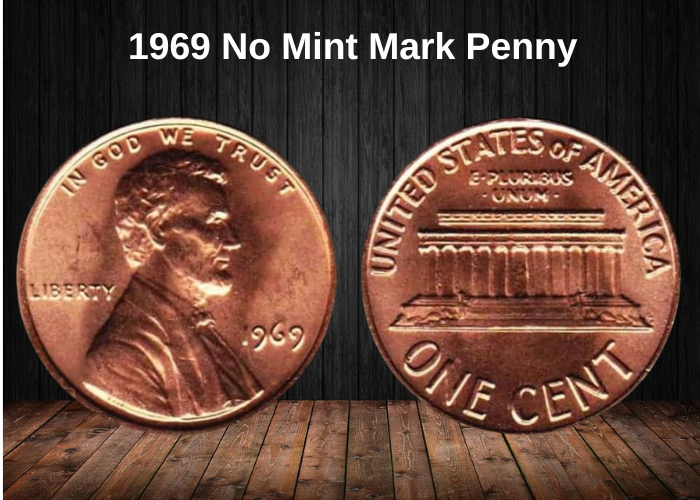
In 1969, the Philadelphia Mint produced approximately 1,136,910,000 Lincoln pennies—an incredibly high mintage by any standard.
As a result, most of these coins were circulated, and it’s still fairly easy to find a 1969 Lincoln penny in grades up to MS65 today. However, examples in higher grades, such as MS68 or above, are much more difficult to come by.
- A brown 1969 no-mint mark penny in circulated condition typically holds a modest value of around $0.05.
- In mint state, values start to rise:
- MS65 brown examples can sell for $2.50
- MS67 brown coins may fetch up to $7.50
Red specimens, which maintain their original luster and show minimal handling marks, are more valuable due to their enhanced eye appeal and better preservation:
- While no circulated red 1969 pennies are known, those in uncirculated condition can reach $575 at MS67.
Notably, the most expensive 1969 red penny graded MS67 sold for an impressive $5,750 in 2010.
1969 D Penny Value
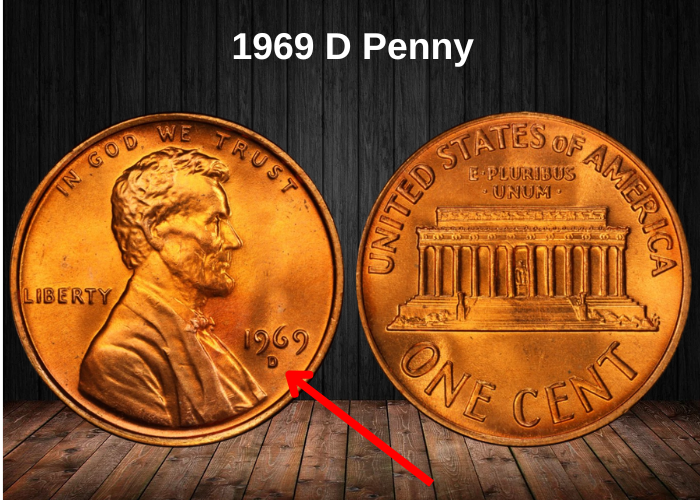
The Denver Mint struck an astounding 4,002,832,200 Lincoln pennies in 1969. Given such an enormous mintage, these coins are extremely common and generally not highly sought after by collectors.
Adding to their lack of appeal, many 1969-D pennies were poorly struck, a common issue with Lincoln cents from the 1960s. As a result, mint state examples—especially in higher grades—are rare and harder to find.
- A brown 1969-D penny holds a value of around $0.05 in circulated condition.
- In mint state, values are still modest:
- At MS65, expect about $2.50
- At MS67, the value rises slightly to $7.50
According to the Professional Coin Grading Service (PCGS), the highest price paid for a brown 1969-D penny was $191, sold in an online auction in 2020.
Red examples of the 1969-D penny are much harder to find, but those that do exist command better prices:
- A red 1969-D penny graded MS66 can be worth around $36
One of the rarest finds was a red MS67 specimen, which fetched an impressive $7,475 in 2010.
1969 S Penny Value
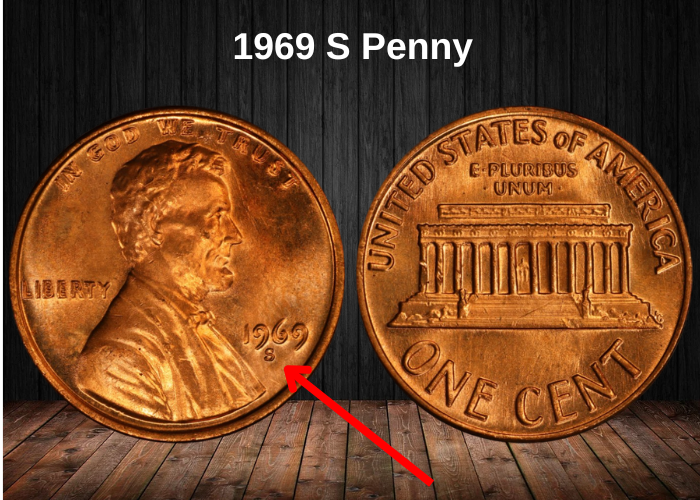
In 1969, the San Francisco Mint struck two types of Lincoln cents: regular business strikes and proof coins. For the regular strike coins, the mint produced approximately 544,375,000 pennies, making them relatively common today.
- In circulated condition, a brown 1969-S penny is worth about $0.05.
- Many examples exist in mint state, and they are easier to find than 1969 pennies from Philadelphia or Denver.
- However, the coins become scarce starting from grade MS68 and above.
Market Values:
- A brown MS67 1969-S penny can sell for around $7.50.
- Red pennies are rarely seen in circulated condition but are more available in mint state.
- A red 1969-S penny graded MS67 can reach prices of up to $350.
1969 S Penny Value (Proof)
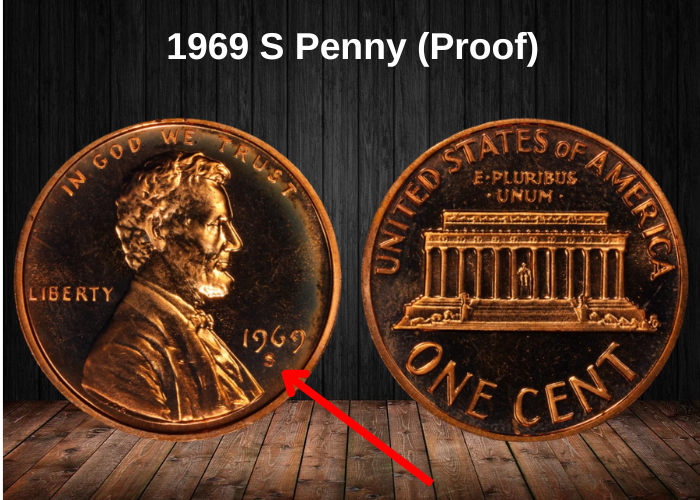
In addition to regular circulation strikes, the San Francisco Mint produced approximately 2,934,631 proof Lincoln pennies in 1969, specifically for collectors.
These proof coins are known for their satin finish, sharp details, and mirror-like backgrounds with frosted design elements, making them highly attractive to numismatists.
You can find 1969-S proof pennies in three finishes:
- Red (standard proof)
- Cameo (CAM)
- Deep Cameo (DCAM) — the most desirable and valuable.
Market Values by Type and Grade:
- A Red proof penny graded PF69 is worth about $30, though one rare example sold for $230 at auction.
- A Cameo proof in the same grade can fetch up to $45.
- A Deep Cameo (DCAM) graded PF69 may sell for as much as $625, depending on market demand and eye appeal.
Rare 1969 Penny Error List
1969 S Double Die Obverse Penny Error
This is one of the most famous and valuable errors in the Lincoln cent series.
First discovered by collectors Bill Hudson and Ceil Moorhouse in the 1970s, the 1969-S Doubled Die Obverse (DDO) quickly drew attention—not just from numismatists, but also from the U.S. Secret Service. Due to widespread counterfeiting attempts, the Secret Service confiscated and destroyed several suspected error coins. While genuine examples were eventually returned to their rightful owners, many were lost forever.
Today, this error coin is extremely rare, with only about 40 to 50 known specimens. The last discovery of a new example occurred in 2007.
How to Identify It:
Look for strong, visible doubling on:
- LIBERTY
- IN GOD WE TRUST
- The date “1969”
Market Value:
A genuine 1969-S Doubled Die penny graded MS-64 Red by PCGS sold for an astonishing $126,500—making it one of the most lucrative Lincoln cent errors ever sold.
1969 D No FG Penny Error
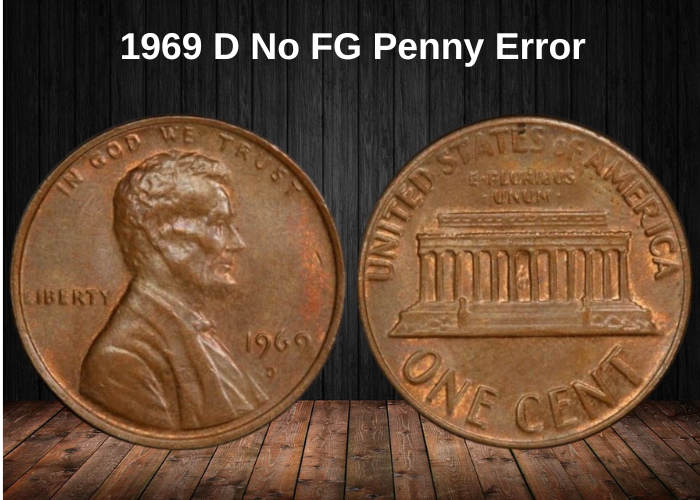
As previously mentioned, Frank Gasparro designed the reverse of the Lincoln Memorial pennies and included his initials, FG, to the right of the memorial hall near the staircase.
However, due to minting errors, some 1969-D pennies struck at the Denver mint do not feature these initials.
These unique error coins are known as 1969-D No FG pennies and are highly sought after by collectors. Depending on the coin’s grade, these rare pennies can fetch up to $210 or more.
Where to sell your penny?
Now that you know the value of your penny, you might be wondering where to sell it. Don’t worry: here’s a guide to some of the best online platforms where you can easily sell your coins, along with their advantages and disadvantages.
Discover the best platforms for selling coins online (pros and cons).
FAQ About the 1969 Lincoln Penny
1. What is the significance of the 1969 Lincoln Penny in the context of U.S. coinage history?
The 1969 Lincoln Penny is part of the Lincoln Memorial series, which began in 1959 and ran until 2008. The 1969 penny features the Lincoln Memorial on the reverse side and a portrait of Abraham Lincoln on the obverse, marking its place in U.S. coinage history as part of the transition to more modern designs. In the broader context of U.S. coinage, the 1969 penny represents a point just before the full shift to clad coins in the mid-1960s, as the 1969 penny still retained the 95% copper composition used before the change.
2. What is the mintage of the 1969 Lincoln Penny, and does it affect its rarity or value?
A total of 2,992,106,000 1969 Lincoln pennies were minted in Philadelphia and Denver, which makes it a high mintage coin. With such a large quantity produced, the 1969 penny is generally not rare or valuable unless it is in mint state or has specific error varieties. Like other pennies of the era, it holds face value unless found in higher grades or with error characteristics.
3. What does the grading of the 1969 penny mean for its value?
The value of a 1969 penny can vary significantly depending on its condition and grade. Coins are graded on a scale from Good to Mint State (MS), with the higher grades being more valuable to collectors. The 1969 penny can still be valuable if it is in unusually high-grade condition, such as an MS 65 or higher. In uncirculated condition, it may have a value of around $1 to $5, but it will not exceed much beyond that in typical market conditions due to the high mintage. Coins that have been preserved well with minimal marks or scratches will always be more desirable.
4. Are there any known errors associated with the 1969 Lincoln penny?
Yes, the 1969 penny is known to have some minting errors that make certain coins more valuable to collectors. One of the most notable errors is the 1969-S Double Die Obverse. This error occurred when the die was improperly aligned during the striking process, resulting in a doubled image of the date and other details on the obverse. The 1969-S Double Die Obverse is considered one of the most famous and valuable errors in the Lincoln penny series. If you happen to find one of these coins in good condition, it could be worth thousands of dollars.
5. What is the difference between the 1969 Lincoln penny and other similar pennies in the same decade?
The 1969 Lincoln penny shares the same basic design as other pennies minted from 1959 onward, featuring the Lincoln Memorial on the reverse. However, it differs from earlier pennies by the fact that it was minted after the U.S. Mint switched to using clad metals for many coins. While the 1969 penny was still 95% copper, its mintage and the surrounding economic conditions during the late 1960s set it apart. The 1969 penny is also part of a transitional period in U.S. coinage history, as the country was adjusting to the rising cost of copper, which would eventually lead to further composition changes in later years.
6. How does the 1969 penny compare to the more rare 1969-S Double Die Obverse?
The 1969-S Double Die Obverse is a rare and highly valuable version of the 1969 Lincoln penny that was struck with a doubled die error, which created a noticeable doubling of the date and Liberty inscription. In contrast, the regular 1969 penny without such an error is not rare and holds little value beyond its face value, unless it is in uncirculated or near mint condition. The 1969-S Double Die can be worth several thousand dollars depending on its grade, while the typical 1969 penny is often found for much less.
7. Can the 1969 Lincoln penny still be found in circulation, and if so, what is its current value?
Yes, the 1969 Lincoln penny can still be found in circulation, though it is not as common as coins from more recent years. In circulated condition, it typically holds face value, which is one cent. However, in uncirculated or high-grade condition, it may be worth slightly more. If a collector is fortunate enough to find a 1969 penny with errors or in high-grade condition, the coin could be valued much higher, especially in the case of the 1969-S Double Die Obverse, which can fetch thousands of dollars at auction.


















































